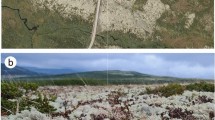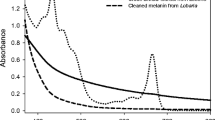Abstract
Three epiphytic old forest lichens (Usnea longissima, Pseudocyphellaria crocata, and Lobaria pulmonaria) were transplanted along a natural shade–sun gradient comprising three successional stages in boreal spruce forests (dense young forest, open old forest, and clear-cut) for one summer. After harvest, extractable secondary compounds were analyzed by high-performance liquid chromatography, and the brown pigmentation in melanic species was quantified by reflectance measurements. Cortical compounds in all species increased from shady young forests to exposed clear-cuts. Usnic acid, the major cortical, secondary compound in U. longissima, showed consistently higher concentration in the clear-cut than in the two forested stands. Pseudocyphellaria crocata and L. pulmonaria, lacking extractable secondary compounds in the cortex, significantly increased their amounts of cortical melanins in well-lit stands. The medullary compounds showed more complex responses. Many were not influenced by environmental conditions during the transplantation, whereas the majority of those that responded showed the lowest concentration in clear-cut transplants. Only a few medullary compounds showed the highest concentration in the clear-cut, and at a low level of significance. The synthesis of UV-B-absorbing usnic acid and melanins seems to be part of an acclimation to increased light exposure. The medullary compounds in studied species barely function as solar screens despite their strong UV-B absorbance.



Similar content being viewed by others
References
Ahmadjian, V. 1959. Experimental observations on the algal genus Trebouxia. De Puymaly. Bot. Tidsskr. 53:71–80.
Anderson, M. C. 1964. Studies of woodland light climate. I. The photographic computation of light conditions. J. Ecol. 52:27–41.
Brown, R. T., and Mikola, P. 1974. The influence of fruticose soil lichens upon the mycorrhizae and seedling growth of forests. Acta For. Fenn. 141:1–23.
Büdel, B., and Lange, O. L. 1994. The role of cortical and epinecral layers in the lichen genus Peltula. Cryptogam. Bot. 4:262–269.
Cocchietto, M., Skert, N., Nimis, P. L., and Sava, G. 2002. A review on usnic acid, and interesting natural compound. Naturwissenschaften 89:137–146.
Dietz, S., Büdel, B., Lange, O. L., and Bilger, W. 2000. Transmittance of light through the cortex of lichens from contrasting habitats. Bibl. Lichenol. 75:171–182.
Emmerich, R., Giez, I., Lange, O. L., and Proksch, P. 1993. Toxicity and antifeedant activity of lichen compounds against the polyphagous insect Spodoptera littoralis. Phytochemistry 33:1389–1394.
Ertl, L. 1951. Über die Lichtverhältnisse in Laubflechten. Planta 39:245–270.
Fahselt, D., and Alstrup, V. 1997. Visualization of extracellular deposits in recent and subfossil Umbilicaria hyperborea. Lichenologist 29:547–557.
Fisher, R. F. 1979. Possible allelopathic effects of reindeer-moss (Cladonia) on jack pine and white spruce. For. Sci. 25:83–95.
Gauslaa, Y. 2005. Lichen palatability depends on investments in herbivore defence. Oecologia 143:94–105.
Gauslaa, Y., and Solhaug, K. A. 1999. High-light damage in air-dry thalli of the old forest lichen Lobaria pulmonaria—interactions of irradiance, exposure duration and high temperature. J. Exp. Bot. 50:697–705.
Gauslaa, Y., and Solhaug, K. A. 2001. Fungal melanins as a sun screen for symbiotic green algae in the lichen Lobaria pulmonaria. Oecologia 126:426–471.
Gauslaa, Y., Palmqvist, K., Solhaug, K. A., Holien, H., Hilmo, O., Nybakken, L., Myhre, L. C., and Ohlson, M. in press. Growth of epiphytic old forest lichens at regional and successional scales. Can. J. For. Res.
Giez, I., Lange, O. L., and Proksch, P. 1994. Growth retarding activity of lichen substances against the polyphagous herbivorous insect Spodoptera littoralis. Biochem. Syst. Ecol. 22:113–120.
Gudjónsdóttir, G. A., and Ingólfsdóttir, K. 1997. Quantitative determination of protolichesterinic acid and fumarprotocetraric acids in Cetraria islandica by high-performance liquid chromatography. J. Chromatogr. A 757:303–306.
Huneck, S., and Yoshimura, I. 1996. Identification of Lichen Substances. Springer, Berlin Heidelberg New York.
Lawrey, J. D. 1983. Lichen herbivory preferences: a test of two hypotheses. Am. J. Bot. 70:1188–1194.
McEvoy, M., Nybakken, L., Solhaug, K. A., and Gauslaa, Y. 2006. UV triggers the synthesis of the widely distributed secondary compound usnic acid. Mycol. Progr. 5:221–229.
Nimis, P. L., and Skert, N. 2006. Lichen chemistry and selective grazing by the coleopteran Lasioderma serricorne. Environ. Exp. Bot. 55:175–182.
Nybakken, L., and Julkunen-Tiitto, R. 2006. UV-B induces usnic acid in reindeer lichens. Lichenologist 38:477–485.
Nybakken, L., Gauslaa, Y., and Solhaug, K. A. 2000. High-light and heat susceptibility of melanic and pale populations of the foliose lichen Lobaria pulmonaria (in Norwegian). Blyttia 58:185–191.
Nybakken, L., Solhaug, K. A., Bilger, W., and Gauslaa, Y. 2004. The lichens Xanthoria elegans and Cetraria islandica maintain a high protection against UV-B radiation in Arctic habitats. Oecologia 140:211–216.
Palmqvist, K. 2000. Carbon economy in lichens. New Phytol. 148:11–36.
Plonka, P. M., and Grabacka, M. 2006. Melanin synthesis in microorganisms—biotechnical and medical aspects. Acta Biochim. Pol. 53:429–443.
Pyatt, F. B. 1967. The inhibitory influence of Peltigera canina on the germination of graminaceous seeds and the subsequent growth of seedlings. Bryologist 70:328–329.
Richardson, D. H. S. 1967. The transplantation of lichen thalli to solve some taxonomic problems in Xanthoria parietina (L.)Th. Fr. Lichenologist 3:386–391.
Rundel, P. W. 1969. Clinal variation in the production of usnic acid in Cladonia subtenuis along light gradients. Bryologist 72:40–44.
Rundel, P. W. 1978. The ecological role of secondary lichen substances. Biochem. Syst. Ecol. 6:157–170.
Slansky, F. 1979. Effect of the lichen chemicals atranorin and vulpinic acid upon feeding and growth of larvae of the yellow-striped armyworm, Spodoptera ornithogalli. Environ. Entomol. 8:865–868.
Solhaug, K. A., Gauslaa, Y., Nybakken, L., and Bilger, W. 2003. UV-induction of sun-screening pigments in lichens. New Phytol. 158:91–100.
Acknowledgements
We thank Kristin Palmqvist, Håkon Holien, Lise Cats Myhre, Olga Hilmo, Mikael Ohlson, and Camilla Iversen for help with collection of lichen samples, set-up and/or maintenance of the experiments. We are also indebted to Professor Harrie Sipman at the Botanical Museum in Berlin, Germany, for giving us standards of the lichen compounds tenuiorin and stictic acid; and to Professor John Elix, University of Canberra, Australia and Professor Riitta Julkunen-Tiitto, University of Joensuu, Finland for help with identification of lichen substances. This study was supported by the Norwegian Research Council (project number 15778/V40).
Author information
Authors and Affiliations
Corresponding author
Rights and permissions
About this article
Cite this article
Nybakken, L., Asplund, J., Solhaug, K.A. et al. Forest Successional Stage Affects the Cortical Secondary Chemistry of Three Old Forest Lichens. J Chem Ecol 33, 1607–1618 (2007). https://doi.org/10.1007/s10886-007-9339-5
Received:
Revised:
Accepted:
Published:
Issue Date:
DOI: https://doi.org/10.1007/s10886-007-9339-5




